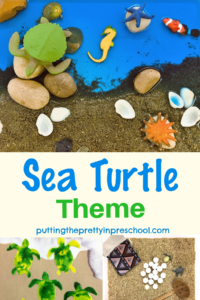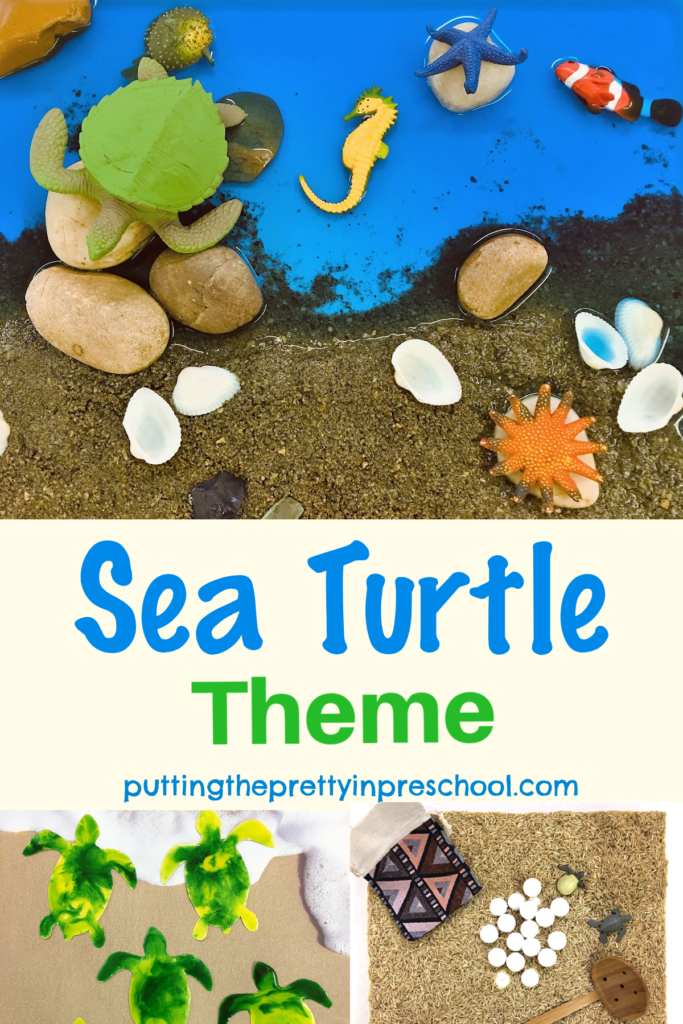
_______
Sea turtles are large, fascinating ocean creatures. After viewing beautiful sea turtle paintings by an artist passionate about conservation and reading a few super interesting storybooks, this sea turtle theme was born. Interesting facts followed by engaging, hands-on activities are included. Green sea turtles are the focus of the theme
Green Sea Turtle Life Stages
One in a thousand baby green sea turtles lives to become an adult. Sea turtles face many challenges in trying to survive. Here’s how they get their start in life.
At night, baby green sea turtles scurry to the ocean from the deep hole they dig out of. They hatch from eggs deposited by their mother (also at night) on a sandy beach above the high tide line. The small, white eggs are buried in a blanket of sand to keep them warm and hide them from predators. The eggs are left alone to incubate for 50 -70 days.
The temperature of the nest determines the sex of the turtles. Warmer eggs become males; cooler eggs become females. Both males and females can dig out of the same nest because the temperature can vary in different parts of it.
The hatchlings hurry to the ocean in the dark when it is less likely that they will be eaten by crabs or shorebirds like gulls or herons. Most babies do not make it to the ocean. Even if they safely make it to the water, they could be eaten by birds hovering above the waves or predatory fish lingering close to shore.
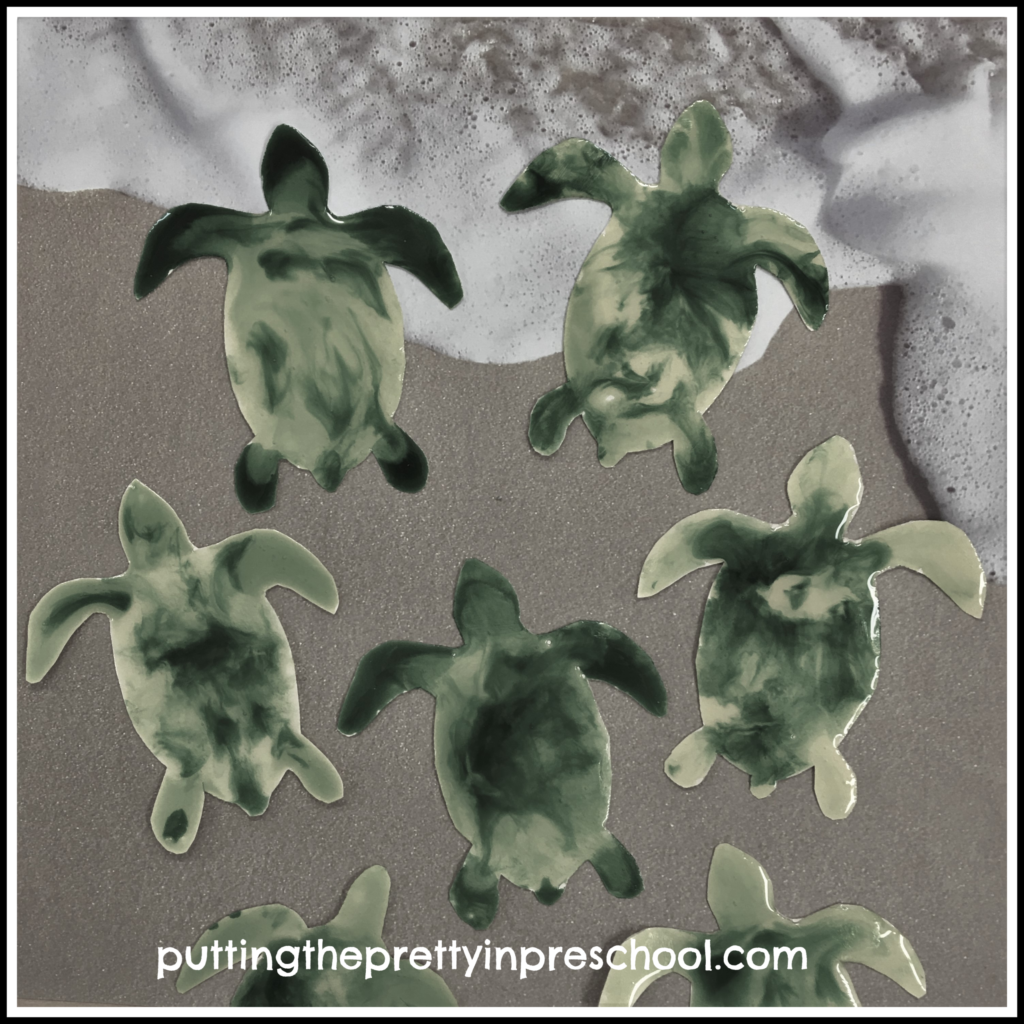
_______
Young green sea turtles spend the first three to five years of their lives in deeper waters. They are carnivores, eating fish eggs, mollusks, jellyfish, worms, sponges, algae, crustaceans, and small invertebrates.
Adults green sea turtles spend most of their time in shallow coastal waters with lush seagrass beds. They are herbivores, relying on food such as seagrasses and algae. Adults are at home in coral reefs, salt marshes, and nearshore grass beds. In these habitats, they have lots of food and protection from predators and rough ocean waves.
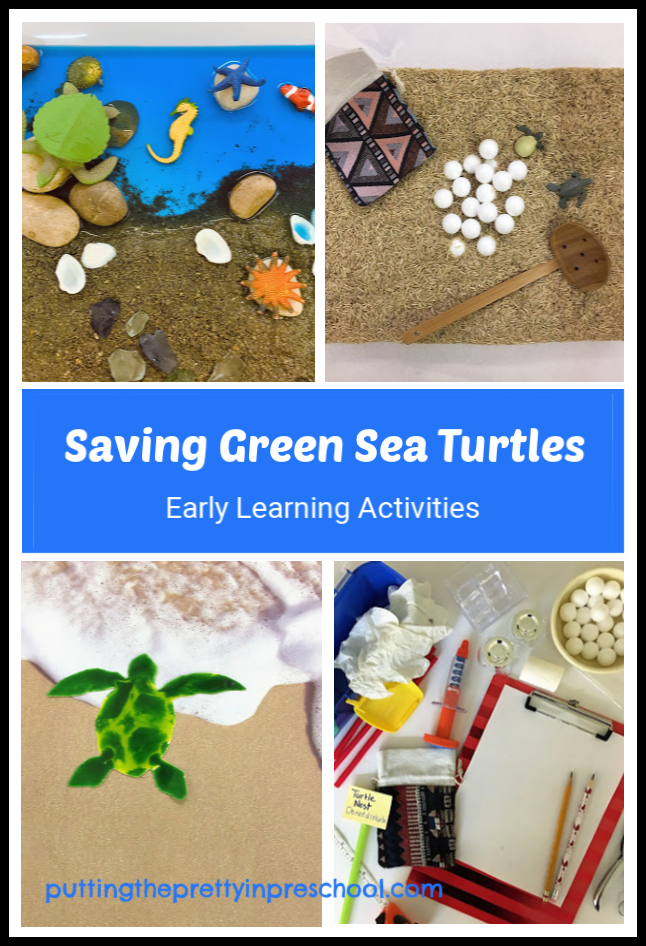
_______
Conservation of Green Sea Turtles
Green sea turtles are endangered. They face a high risk of extinction in the wild. The turtles are protected by law in most countries. Many countries also protect their nesting areas.
Some threats green sea turtles face:
- Loss of nesting areas due to real estate development in coastal areas.
- Poaching: There is the illegal trade of eggs, meat, and shells. The skin is used for shoes, belts, and bags. The meat is used to make exotic dishes like turtle soup. Turtle oil is used for cosmetics.
- Plastic and other marine debris
_______
Help Keep Green Sea Turtles Alive
We can help green sea turtles stay alive! We can:
- read books about green sea turtles and how to help them survive.
- limit the use of plastic and recycle the plastic we use.
- buy sustainably harvested, ocean-friendly seafood.
- support organizations that help protect green sea turtles and their habitats.
- share social media posts about sea turtles and efforts to protect them.
_______
People who live close to a sea turtle nesting area can:
- join a beach clean-up.
- volunteer for a turtle watch night shift.
- turn off porch lights at night.
- refrain from using flashlights or making bonfires during nesting season.
Porch lights, flashlights, and bonfires disorient hatchlings. They can head away from the ocean instead of toward it.
_______
Green Sea Turtle Activities
Green Sea Turtle Small World
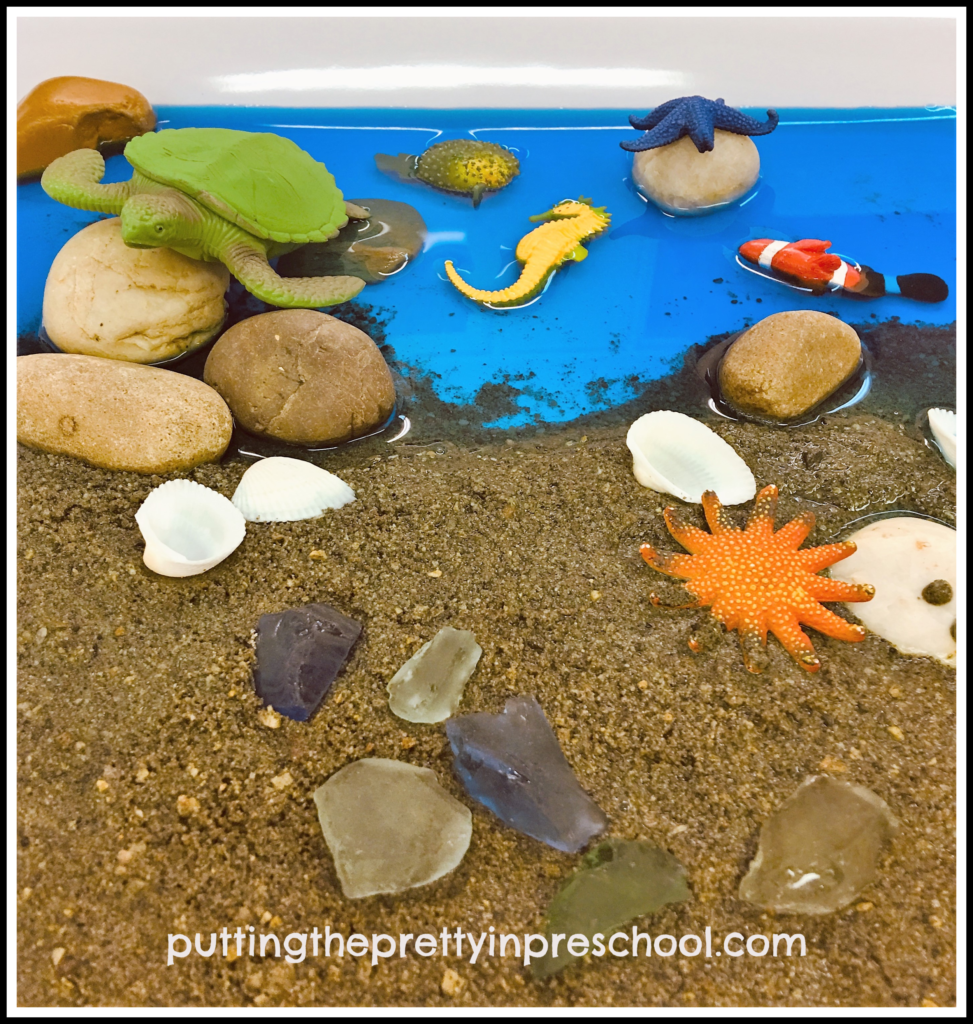
_______
This small world includes a green sea turtle in a beach scene.
Materials used:
- play sand
- water
- blue liquid watercolor (to color the water)
- rocks (different sizes and colors)
- sea turtle
- sea glass
- small shells
- fish
Another way to feature the items in this sensory bin is to add them to different compartments of a clear plastic drawer tray. The drawer tray option includes green sea turtles at different life stages.
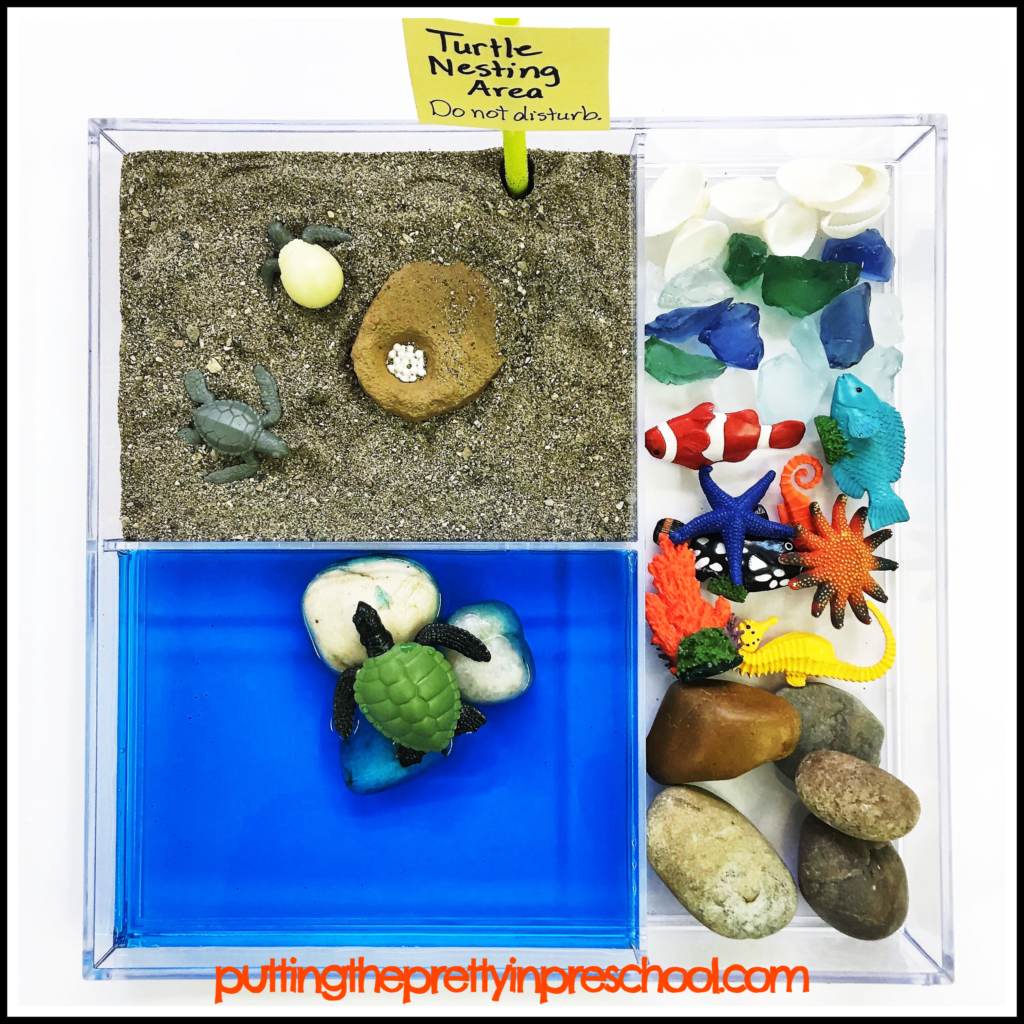
_______
These small worlds are inspired by the art of Carleen Ross. Carleen has authored a gorgeous book featuring her art and sea turtle facts called “Journey To The Sea Turtle”. (CarleenRossArt.com)
_______
Painted Sea Turtle Hatchlings
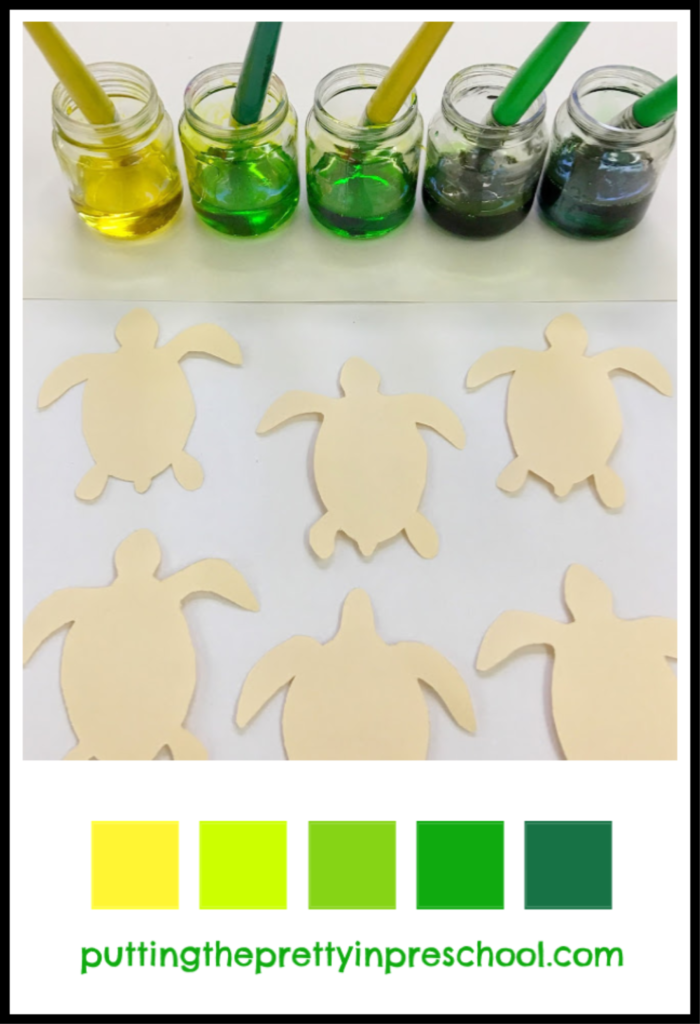
_______
Create gorgeous sea turtle hatchlings with this shiny paint in a few different hues.
Supplies needed:
- white corn syrup
- green food coloring
- neon green food coloring
- yellow food coloring
- small jars
- spoons for stirring paints
- paintbrushes
- manila paper turtle shapes
Add green and neon green food coloring in different amounts to a few small jars filled with white corn syrup. Add a little yellow food coloring to one jar with green. Mix the paints to make lighter and darker shades of green and yellow-green. Add yellow food coloring to one jar of corn syrup and stir.
Paint the sea turtle hatchlings.
Note: This paint is sticky, and will take at least a week to dry completely. It dries with a beautiful, smooth finish.

_______
This art activity is inspired by the art piece “Baby Honus” by Cas Plester. (chillpineappleart.ca)
_______
Egg And Hatchling Sensory Bin
Sometimes scientists move sea turtle eggs to a safer, drier place and bury them there. This conservation activity is replicated in this egg and hatchling rice bin.
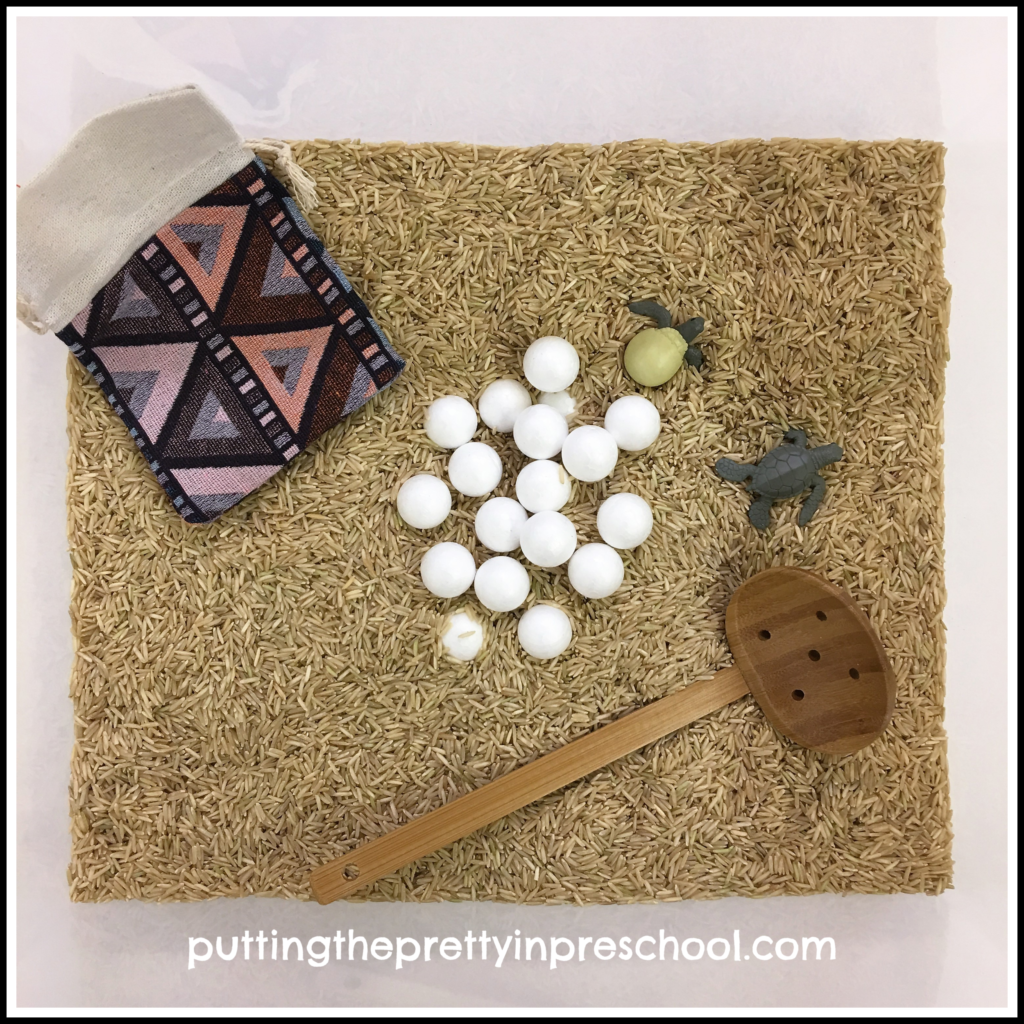
_______
Add the following items to a sensory bin:
- brown rice
- cloth Bag
- white styrofoam balls (sea turtle eggs)
- sea turtle hatchling
- juvenile sea turtle
- scoop
A red light can be shined on this sensory bin. Scientists and volunteers use a red turtle-friendly light to carry out their night watch sea turtle activities.

_______
Sea Turtle Dramatic Play Kit
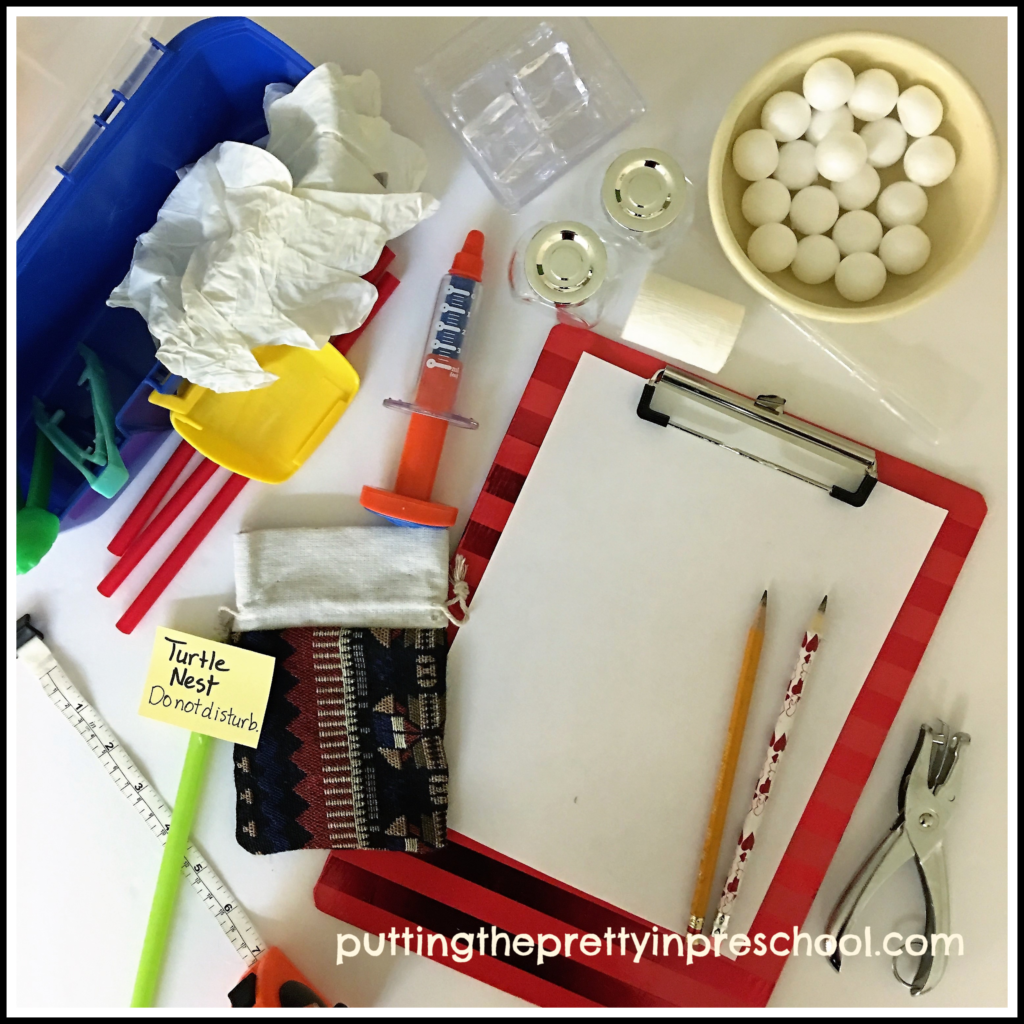
_______
Add supplies used by sea turtle scientists and turtle watch volunteers to a dramatic play center:
- toolbox
- clipboard, paper, and pencils (to take down data)
- measuring tape to measure nest locations or sea turtle lengths
- stakes (to mark nest locations)
- cloth bag (to relocate turtle eggs if needed)
- ice (to chill “tissue or blood samples”)
- needle
- dry gauze
- plastic specimen jars
- tag applicator
- rubber gloves
_______
Feature Conservation Organization
The organization WIDECAST
- studies sea turtles.
- educates children and adults about sea turtle conservation.
- organizes beach cleanups.
- recruits volunteers for nightly patrol of sea turtle nesting grounds.
- promotes alternative sources of income to poaching, i.e. making jewelry with sea glass.
- lobbies governments for stronger regulations to protect sea turtles and their nesting sites.
WIDECAST is showcased in an excellent non-fiction picture book called Sea Turtle Scientist by Stephen R. Swinburne.
_______
[Read more…] about Sea Turtle Theme Activities